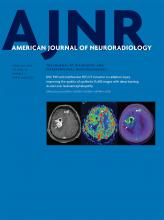Index by author
Ogilvy, C.S.
- InterventionalYou have accessEndothelialization following Flow Diversion for Intracranial Aneurysms: A Systematic ReviewK. Ravindran, M.M. Salem, A.Y. Alturki, A.J. Thomas, C.S. Ogilvy and J.M. MooreAmerican Journal of Neuroradiology February 2019, 40 (2) 295-301; DOI: https://doi.org/10.3174/ajnr.A5955
Olsson, D.
- LetterYou have accessIs Delayed Speech Development a Long-Term Sequela of Birth-Related Subdural Hematoma?N. Lynøe, D. Olsson and A. ErikssonAmerican Journal of Neuroradiology February 2019, 40 (2) E10; DOI: https://doi.org/10.3174/ajnr.A5890
Oswood, M.C.
- FELLOWS' JOURNAL CLUBAdult BrainOpen AccessAcute Toxic Leukoencephalopathy: Etiologies, Imaging Findings, and Outcomes in 101 PatientsC. Özütemiz, S.K. Roshan, N.J. Kroll, J.C. Benson, J.B. Rykken, M.C. Oswood, L. Zhang and A.M. McKinneyAmerican Journal of Neuroradiology February 2019, 40 (2) 267-275; DOI: https://doi.org/10.3174/ajnr.A5947
Of 101 included patients, the 4 subgroups of >6 were the following: chemotherapy (n = 35), opiates (n = 19), acute hepatic encephalopathy (n = 14), and immunosuppressants (n = 11). Other causes (n = 22 total) notably included carbon monoxide (n = 3) metronidazole (n = 2), and uremia (n = 1). Acute hepatic/hyperammonemic encephalopathy clinically resolved in 36%, with severe outcomes in 23% (coma or death, 9/16 deaths from fludarabine). Notable laboratory results were elevated CSF myelin basic protein levels in 8/9 patients and serum blood urea nitrogen levels in 24/91. Acute toxic leukoencephalopathy is an imaging appearance that can arise from various etiologies, with potentially reversible reduced diffusion predominately affecting the periventricular WM. Given the shared DWI appearance among this heterogeneous array of etiologies, their outcomes may differ. Thus, the neurologic symptoms completely resolved in 36%, while severe outcomes occurred in 23%. The clinical outcome was most severe with chemotherapy-related ATL.
Otsuka, Y.
- EDITOR'S CHOICEAdult BrainOpen AccessImproving the Quality of Synthetic FLAIR Images with Deep Learning Using a Conditional Generative Adversarial Network for Pixel-by-Pixel Image TranslationA. Hagiwara, Y. Otsuka, M. Hori, Y. Tachibana, K. Yokoyama, S. Fujita, C. Andica, K. Kamagata, R. Irie, S. Koshino, T. Maekawa, L. Chougar, A. Wada, M.Y. Takemura, N. Hattori and S. AokiAmerican Journal of Neuroradiology February 2019, 40 (2) 224-230; DOI: https://doi.org/10.3174/ajnr.A5927
Forty patients with MS were prospectively included and scanned (3T) to acquire synthetic MR imaging and conventional FLAIR images. Synthetic FLAIR images were created with the SyMRI software. Acquired data were divided into 30 training and 10 test datasets. A conditional generative adversarial network was trained to generate improved FLAIR images from raw synthetic MR imaging data using conventional FLAIR images as targets. The peak signal-to-noise ratio, normalized root mean square error, and the Dice index of MS lesion maps were calculated for synthetic and deep learning FLAIR images against conventional FLAIR images, respectively. Lesion conspicuity and the existence of artifacts were visually assessed. The peak signal-to-noise ratio and normalized root mean square error were significantly higher and lower, respectively, in generated-versus-synthetic FLAIR images in aggregate intracranial tissues and all tissue segments. The Dice index of lesion maps and visual lesion conspicuity were comparable between generated and synthetic FLAIR images. Using deep learning, the authors conclude that they improved the synthetic FLAIR image quality by generating FLAIR images that have contrast closer to that of conventional FLAIR images and fewer granular and swelling artifacts, while preserving the lesion contrast.








